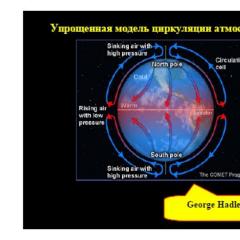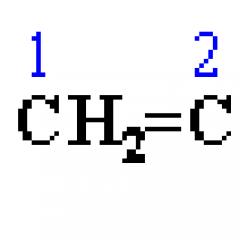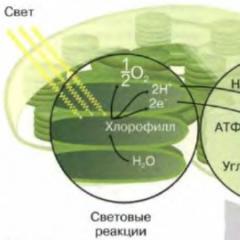Circumference of a hexagon formula. Regular hexagon: why it is interesting and how to build it. What properties do you need to know when solving problems?
Construction of a regular hexagon inscribed in a circle. The construction of a hexagon is based on the fact that its side is equal to the radius of the circumscribed circle. Therefore, to construct it, it is enough to divide the circle into six equal parts and connect the found points to each other (Fig. 60, a).
A regular hexagon can be built using a straight edge and a 30X60° square. To carry out this construction, we take the horizontal diameter of the circle as the bisector of angles 1 and 4 (Fig. 60, b), construct sides 1 -6, 4-3, 4-5 and 7-2, after which we draw sides 5-6 and 3- 2.
Constructing an equilateral triangle inscribed in a circle. The vertices of such a triangle can be constructed using a compass and a square with angles of 30 and 60° or just one compass.
Let's consider two ways to construct an equilateral triangle inscribed in a circle.
First way(Fig. 61,a) is based on the fact that all three angles of the triangle 7, 2, 3 contain 60°, and the vertical line drawn through point 7 is both the height and the bisector of angle 1. Since the angle is 0-1- 2 is equal to 30°, then to find the side

1-2, it is enough to construct an angle of 30° from point 1 and side 0-1. To do this, install the crossbar and square as shown in the figure, draw line 1-2, which will be one of the sides of the desired triangle. To construct side 2-3, set the crossbar in the position shown by the dashed lines, and draw a straight line through point 2, which will determine the third vertex of the triangle.
Second way is based on the fact that if you build a regular hexagon inscribed in a circle and then connect its vertices through one, you will get an equilateral triangle.
To construct a triangle (Fig. 61, b), mark the vertex-point 1 on the diameter and draw a diametrical line 1-4. Next, from point 4 with a radius equal to D/2, we describe an arc until it intersects with the circle at points 3 and 2. The resulting points will be the other two vertices of the desired triangle.
Constructing a square inscribed in a circle. This construction can be done using a square and a compass.
The first method is based on the fact that the diagonals of the square intersect in the center of the circumscribed circle and are inclined to its axes at an angle of 45°. Based on this, we install the crossbar and square with angles of 45° as shown in Fig. 62, a, and mark points 1 and 3. Next, through these points we draw the horizontal sides of the square 4-1 and 3-2 using a crossbar. Then, using a straight edge, we draw the vertical sides of the square 1-2 and 4-3 along the leg of the square.
The second method is based on the fact that the vertices of the square bisect the arcs of the circle enclosed between the ends of the diameter (Fig. 62, b). We mark points A, B and C at the ends of two mutually perpendicular diameters and from them with a radius y we describe arcs until they intersect each other.
Next, through the intersection points of the arcs we draw auxiliary straight lines, marked in the figure with solid lines. The points of their intersection with the circle will determine vertices 1 and 3; 4 and 2. We connect the vertices of the desired square obtained in this way in series with each other.

Construction of a regular pentagon inscribed in a circle.
To fit a regular pentagon into a circle (Fig. 63), we make the following constructions.
We mark point 1 on the circle and take it as one of the vertices of the pentagon. We divide the segment AO in half. To do this, we describe an arc from point A with the radius AO until it intersects with the circle at points M and B. By connecting these points with a straight line, we get point K, which we then connect to point 1. With a radius equal to the segment A7, we describe an arc from point K until it intersects with the diametrical line AO at point H. By connecting point 1 with point H, we get the side of the pentagon. Then, using a compass solution equal to the segment 1H, describing an arc from vertex 1 to the intersection with the circle, we find vertices 2 and 5. Having made notches from vertices 2 and 5 with the same compass solution, we obtain the remaining vertices 3 and 4. We connect the found points sequentially with each other.

Constructing a regular pentagon along a given side.
To construct a regular pentagon along a given side (Fig. 64), we divide the segment AB into six equal parts. From points A and B with radius AB we describe arcs, the intersection of which will give point K. Through this point and division 3 on line AB we draw a vertical line.
We get point 1-vertex of the pentagon. Then, with a radius equal to AB, from point 1 we describe an arc until it intersects with the arcs previously drawn from points A and B. The intersection points of the arcs determine the pentagon vertices 2 and 5. We connect the found vertices in series with each other.
Construction of a regular heptagon inscribed in a circle.
 Let a circle of diameter D be given; you need to fit a regular heptagon into it (Fig. 65). Divide the vertical diameter of the circle into seven equal parts. From point 7 with a radius equal to the diameter of circle D, we describe an arc until it intersects with the continuation of the horizontal diameter at point F. We call point F the pole of the polygon. Taking point VII as one of the vertices of the heptagon, we draw rays from the pole F through even divisions of the vertical diameter, the intersection of which with the circle will determine the vertices VI, V and IV of the heptagon. To obtain vertices / - // - /// from points IV, V and VI, draw horizontal lines until they intersect with the circle. We connect the found vertices sequentially to each other. A heptagon can be constructed by drawing rays from the F pole and through odd divisions of the vertical diameter.
Let a circle of diameter D be given; you need to fit a regular heptagon into it (Fig. 65). Divide the vertical diameter of the circle into seven equal parts. From point 7 with a radius equal to the diameter of circle D, we describe an arc until it intersects with the continuation of the horizontal diameter at point F. We call point F the pole of the polygon. Taking point VII as one of the vertices of the heptagon, we draw rays from the pole F through even divisions of the vertical diameter, the intersection of which with the circle will determine the vertices VI, V and IV of the heptagon. To obtain vertices / - // - /// from points IV, V and VI, draw horizontal lines until they intersect with the circle. We connect the found vertices sequentially to each other. A heptagon can be constructed by drawing rays from the F pole and through odd divisions of the vertical diameter.
The above method is suitable for constructing regular polygons with any number of sides.
The division of a circle into any number of equal parts can also be done using the data in Table. 2, which provides coefficients that make it possible to determine the dimensions of the sides of regular inscribed polygons.

Regular hexagon A hexagon is a polygon with six corners. Any object of this shape is also called a hexagon. The sum of the internal angles of a convex hexagon p ... Wikipedia
Hexagon of Saturn- A hexagonal stable atmospheric formation at the north pole of Saturn, discovered by Voyager 1 and observed again in 2006 and ... Wikipedia
Regular polygon- Regular heptagon A regular polygon is a convex polygon in which all sides and angles are equal. The definition of a regular polygon may depend on the definition of... Wikipedia
Regular heptagon- A regular heptagon is a regular polygon with seven sides. Contents... Wikipedia
Regular triangle- Regular triangle. A regular (or equilateral) triangle is a regular polygon with three sides, the first of the regular polygons. All sides... Wikipedia
Regular hexagon is a regular polygon with nine sides. Properties of the Rules ... Wikipedia
Regular 17-gon- Regular hexagon geometric figure, belonging to the group of regular polygons. It has seventeen sides and seventeen angles, all its angles and sides are equal to each other, all the vertices lie on the same circle. Contents 1... ...Wikipedia
Regular hexagon- a geometric figure belonging to the group of regular polygons. It has seventeen sides and seventeen angles, all its angles and sides are equal to each other, all the vertices lie on the same circle. Contents... Wikipedia
Regular octagon- (octagon) a geometric figure from a group of regular polygons. It has eight sides and eight angles and all angles and sides are equal to each other... Wikipedia
Regular 65537-gon- 65537 square or circle? Regular 65537 triangle (sixty-five thousand five hundred thirty-seven) a geometric figure from a group of regular polygons, consisting of 65537 ... Wikipedia
Books
- Sets "Magic Edges" No. 25, . Set for assembling 3 cubes with sections. Each cube has moving parts where the section passes. This allows you to see the cube as a whole and in cross-section. Collected three cubes allow you to solve problems...
Do you know what a regular hexagon looks like?
This question was not asked by chance. Most 11th grade students don't know the answer to this.
A regular hexagon is one in which all sides are equal and all angles are also equal..
Iron nut. Snowflake. A cell of a honeycomb in which bees live. Benzene molecule. What do these objects have in common? - The fact that they all have a regular hexagonal shape.

Many schoolchildren get confused when they see problems involving a regular hexagon and believe that some special formulas are needed to solve them. Is it so?
Let's draw the diagonals of a regular hexagon. We got six equilateral triangles. 
We know that the area of a regular triangle is: .
Then the area of a regular hexagon is six times greater.
Where is the side of a regular hexagon.
Please note that in a regular hexagon, the distance from its center to any of the vertices is the same and is equal to the side of the regular hexagon.
This means that the radius of a circle circumscribed around a regular hexagon is equal to its side.
The radius of a circle inscribed in a regular hexagon is not difficult to find.
It is equal.
Now you can easily solve any Unified State Examination tasks, in which a regular hexagon appears.
Find the radius of a circle inscribed in a regular hexagon with side .

The radius of such a circle is equal to .
Answer: .
What is the side of a regular hexagon inscribed in a circle whose radius is 6?

We know that the side of a regular hexagon is equal to the radius of the circle circumscribed around it.
Do you know what a regular hexagon looks like?
This question was not asked by chance. Most 11th grade students don't know the answer to this.
A regular hexagon is one in which all sides are equal and all angles are also equal..
Iron nut. Snowflake. A cell of a honeycomb in which bees live. Benzene molecule. What do these objects have in common? - The fact that they all have a regular hexagonal shape.

Many schoolchildren get confused when they see problems involving a regular hexagon and believe that some special formulas are needed to solve them. Is it so?
Let's draw the diagonals of a regular hexagon. We got six equilateral triangles. 
We know that the area of a regular triangle is: .
Then the area of a regular hexagon is six times greater.
Where is the side of a regular hexagon.
Please note that in a regular hexagon, the distance from its center to any of the vertices is the same and is equal to the side of the regular hexagon.
This means that the radius of a circle circumscribed around a regular hexagon is equal to its side.
The radius of a circle inscribed in a regular hexagon is not difficult to find.
It is equal.
Now you can easily solve any USE problems that involve a regular hexagon.
Find the radius of a circle inscribed in a regular hexagon with side .

The radius of such a circle is equal to .
Answer: .
What is the side of a regular hexagon inscribed in a circle whose radius is 6?

We know that the side of a regular hexagon is equal to the radius of the circle circumscribed around it.



